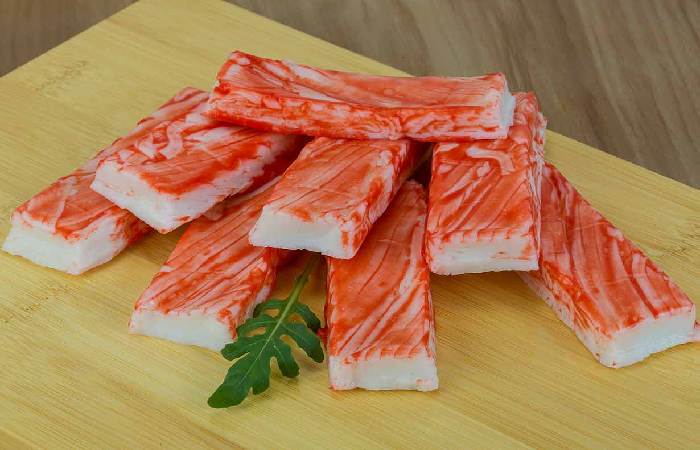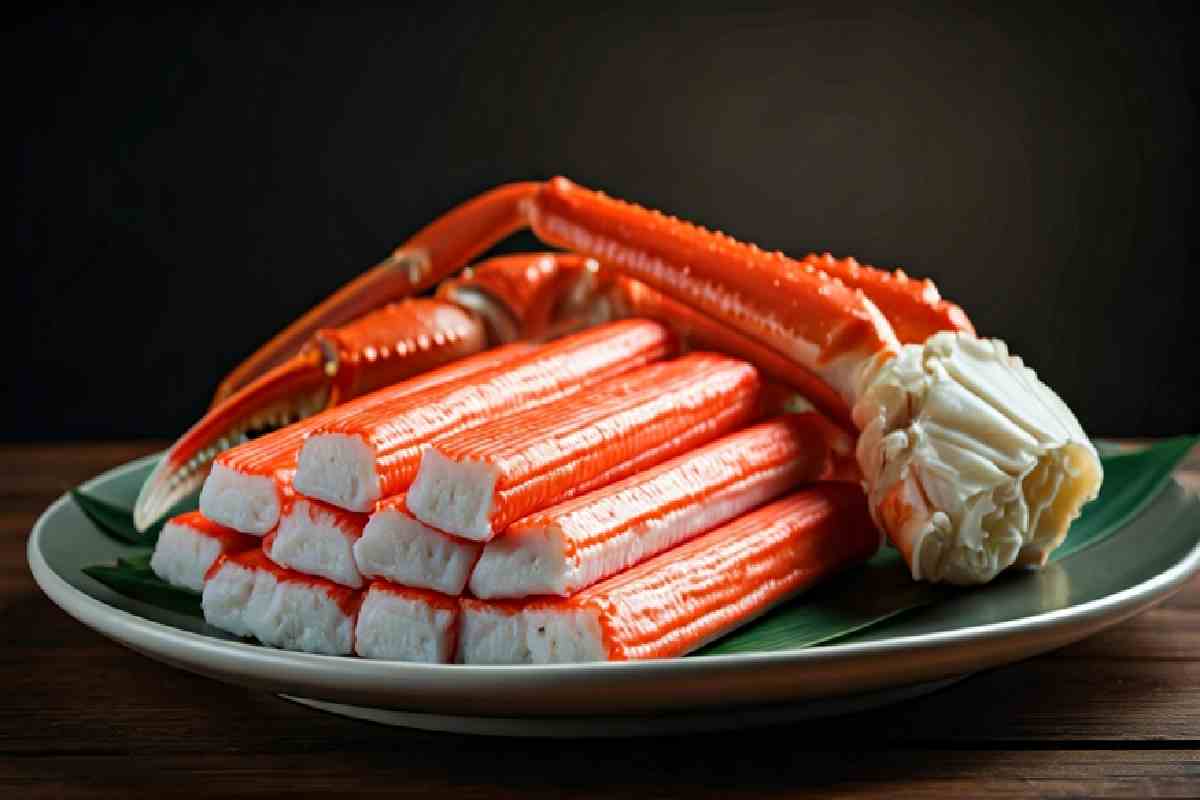Table of Contents
Introduction
If you have ever wondered what imitation crab is, you are not the only one. This seafood substitute tries to look and taste like real crab meat. You will often find it in sushi rolls, crab sticks, and seafood salads. Imitation crab is a good and low-cost choice if you want to use it in your cooking. It is also easy to use and adds variety to many dishes. But, it is not the same as the fresh crab that you might eat at a seafood dinner.
In the next parts, we will talk about how imitation crab is made, what it gives you in terms of nutrition, and how it stacks up against real crab meat.
Understanding Imitation Crab: The Basics
The making of imitation crab starts with surimi. Surimi is a fish paste made by mincing white fish, most often Alaska pollock. This paste is then mixed with additives and formed so it looks like crab sticks or crab chunks. Most of the time, it does not have much or any real crab meat in it.
Imitation crab has become popular mainly because it is not as expensive as fresh crab meat. People also like how easy it is to use in seafood and sushi recipes. You can find it in many dishes such as sushi rolls and seafood salads instead of using fresh crab. Next, we will talk about what goes into it and its history, so you can get a better idea of this imitation seafood product.
What Exactly Is Imitation Crab?

Imitation crab is a type of processed seafood made mainly from surimi. Surimi is the flesh of fish that is taken off the bones, washed, and ground up. The fish meat is turned into a paste. This paste is then mixed with things like starch and different flavorings. After that, it gets shaped to look like crab meat or fish sticks.
A big part of what gives imitation crab its taste comes from crab flavoring or crab extract. It is also colored to look like real crab. Most of the time, Alaska pollock is used for this seafood paste. This fish has a soft taste and a white color, which works well for this product.
You will often see the name “imitation crab” or “krab” on packages, so people know that it isn’t real crab meat. There are rules for how these surimi-based products are labeled. Many dishes like sushi rolls or crab salads use imitation crab. This makes it a handy ingredient to have in your kitchen for different kinds of seafood and sushi recipes. This paste is also a good and simple way for people to enjoy the flavor of crab without using real crab meat.
Why Was Imitation Crab Invented?
Imitation crab started in Japan in the 1970s. People made it as an affordable alternative to real crab and fresh crab meat. The price of fresh crab was high, so manufacturers used surimi to make something with the same flavor and feel as real crab. In Japan, people called this product “kanikama.” It let people enjoy dishes like sushi and seafood salads without paying the high price for fresh crab.
At that time, there was more demand for seafood in different parts of the world, mostly in Western countries. By the 1980s, imitation crab became popular everywhere. It was used in fast food and packaged meals. People liked it because it was not expensive and easy to prepare.
Today, imitation crab still helps with money and environmental problems. It makes it easier for people around the world to use crab substitutes like imitation crab in many ways.
Key Ingredients Found in Imitation Crab
Making imitation crab uses a mix of surimi, water, starch, and protein. This keeps the cost low and helps it look and feel like real crab. To make the seafood paste taste better, flavorings, additives, sugar, and colors are added.
Surimi is the main thing in the ingredient list, but all the extra additives help the paste freeze well and last longer. The next sections will talk more about some of the Exact ingredients used to make imitation crab, like what kind of fish is in it and which preservatives are put in during production.
Main Fish Used in Production
Alaska pollock is the main white fish used to make imitation crab. People use it because the flavor is light and the color is pale. Sometimes, other white fish like cod or Pacific whiting are used instead. This depends on which type is easy to get in the area.
Here’s a look at some white fish often used for imitation crab:
| Fish Type | Characteristics |
| Alaska Pollock | Mild flavor and smell; a cost-effective fish |
| Cod | It is firmer than other fish and has more protein |
| Pacific Whiting | Has a softer texture and the price changes often |
The fish you pick may change based on where you live. But all these white fish help make surimi. Surimi is used to make many seafood items like crab sticks, seafood paste, and other imitation seafood products. Each type helps the paste taste or feel like real crab.
Additives, Preservatives, and Colorings
Imitation crab has many additives in it. These help make the texture right, bring out the taste, and let it stay fresh longer. You will often find monosodium glutamate, or MSG, which is used to make the flavor stronger. There are also carrageenan gums that hold the ingredients together.
Some colorings, like carmine and paprika, give imitation crab the same red look as real crab meat. Sodium benzoate and phosphate-based additives act as preservatives. They help keep the imitation crab good to eat for a longer time. Still, some people worry about these additives. MSG has been linked to mild headaches in some people. Carrageenan has been talked about because it might lead to problems in the intestines.
Additives like these help make the cost, color, and feel of imitation crab right for both the manufacturers and the people who buy it. But they also make imitation crab a more processed kind of food.
Comparing Imitation Crab to Real Crab
Imitation crab looks and is used like real crab, but it is very different in what it gives your body and what it is made from. It has less protein and not as much zinc or selenium as fresh crab meat. There are also more carbohydrates in imitation crab.
The taste and the way it feels to eat are also quite different from real crab. Imitation crab is easy to use as a substitute, but it is not the same as eating fresh crab. Let’s look at these differences more closely, from health benefits to how you can use each one in the kitchen.
Nutrition Differences and Health Considerations
When looking at nutrition, imitation crab has less protein and not as many good nutrients as real crab meat does. Here’s how the two compare:
| Nutrient | Imitation Crab (3 oz) | Real Crab (3 oz) |
| Protein | 6.5 g | 16.5 g |
| Calories | 81 calories | 82 calories |
| Carbs | 12.8 g | 0 g |
| Sodium | 450 mg | 910 mg |
| Vitamin B12 | 21% DV | 408% DV |
| Zinc | 3% DV | 59% DV |
Imitation crab has less sodium than real crab, but it does not give you as much nutrition. For example, real crab, like Alaska king crab, has more protein, zinc, and vitamin B12 than the imitation version.
Taste, Texture, and Culinary Uses
When you look at how imitation crab is used in food, it is clear it is easy to use but does not taste or feel like real crab. The crab flavor is not the same as with fresh crab meat. It does not have the sweet taste you get from fresh crab. The texture is also different. Imitation crab is softer and not as firm or fibrous as real crab.
Imitation crab can be good if you are making California sushi rolls, seafood salads, or a stir-fry. Still, dishes like crab cakes and chowders usually taste better when you use fresh crab. For people who want a seafood meal and need to save money, imitation crab is a good thing to get. But if you use real crab instead, it makes the food taste much better.
Conclusion
To sum up, imitation crab gives you a mix of convenience, good taste, and many ways to use it. That is why this seafood is chosen by lots of people, especially those who want a cheaper option. If you know what the main ingredients are, how the nutrition changes, and the different ways to cook it, you can make better choices in the kitchen. You can add imitation crab to a salad, or use it in your best recipes. It can be a good and filling option for you. If you want to know more, or if you need help with using imitation crab in your food, you can ask for a free consultation.
Frequently Asked Questions
Is imitation crab safe for people with shellfish allergies?
No, imitation crab can still be risky for people who have shellfish allergies. Even though it is mostly made from surimi and white fish, it might have crab extract or other seafood additives in it. You should always check the ingredient list to make sure it is safe for you.
Can vegans or vegetarians eat imitation crab?
Imitation crab is not good for vegans or vegetarians. This is because it has surimi, which is made from fish, and it often has egg whites, too. The way imitation crab is made fits better with seafood diets, not with plant-based diets.
How can you tell the difference between real and imitation crab?
Look at the outside of the crab for any fake orange color or spots that look off. Real crab has a natural red look, and its meat is stringy. Imitation crab feels smooth and can taste a bit fake. Imitation crab is also easy to spot because labels always say what the product is.
Does imitation crab contain gluten?
Gluten can be in imitation crab because people often use wheat starch to make it thicker. If you need to avoid gluten, check the ingredient list. Look for words like starch and additives to see if these or other sources of gluten are in your imitation crab.
What are the best ways to use imitation crab in recipes?
Imitation crab works well in many seafood dishes, such as sushi rolls, seafood salads, and crab sticks. This food is already cooked, so you can use it for dips, casseroles, and stir-fries without extra steps. It helps you save time when you make meals, and it is a budget-friendly choice that gives you different ways to enjoy crab flavor.

